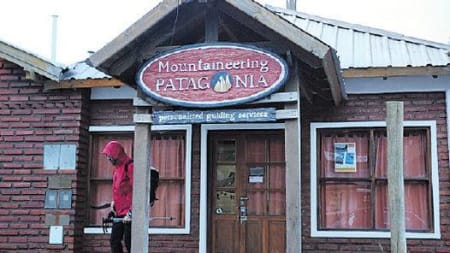Unfortunately the Mexican did not survive and died from hypothermia. Yesterday, the helicopter could not reach the ice cave where the two guides await. If the weather does not improve, they will have to be evacuated on foot.

Mountaineering Patagonia Guide Office in EL Chalten closed yesterday
If the continental ice sheet was not there then the Nunatak Viedma would be a mountain. But it's just a rock formation in the middle of the ice. Wind gusts reach up to 100 kilometers per hour and never drop below 50. The snow gets whipped up and dropped. And so the cycle goes on. When this happens, the sunlight is just a wish.
Pressed against the rock, sheltering in a snow cave made with hands, the two climbers lost contact with a group of twelve rescuers and the body of a dead Mexican partner. They know that only a miracle could bring a helicopter, there will be no choice but to continue walking on the ice and that they will have to leave the body of mexican client, Mario Corsalini.
Yesterday, that was the situation Merlin Lipshitz and Damian Vilches, guide and assistant to the Mexican Corsalini had hired to cross the Southern Patagonian Ice Field in an expedition of thirteen days and 130 kilometers. The same wind that on Monday had destroyed the tent stopped the rescue helicopter from getting to the Gendarmerie.
The rescue is now in the hands of the "Rescate de El Chalten", a group of climbers themselves and the unique ability to deal with risk. The most certain thing yesterday was to wait for the two climbers to recover from hypothermia to launch a return on foot.
At 23:48 pm on Monday 29, Merlin Lipshitz reached for his phone to send the exact position where the group had been stranded. Nothing more. It took more than twelve hours for Marina, his wife, to receive the first call for help. It was not until late Tuesday that the rescue group realized the gravity of what was happening: "We are in the oven," he managed to say.
Everyone froze. Merlin is not only one of the most prestigious guides Argentina. In addition, he speaks little and never loses his cool. The coordinator of the rescue, knew she had to act fast. While she was trying to find a helicopter that rarely arrives on time, a first group of four rescuers went in search of companions who had been stranded.
But by that time, the fate of Corsalini was cast and he suffered severe symptoms of hypothermia. Attempts to revive him by the guides did not work. The odyssey began the night before when a gust blew away the tent where they slept. With the tent was backpacks and food. In a second, everything was covered by snow. Merlin decided to take refuge in a self built snow cave. But little by little the snow covered again. Merlin called on the telephone. He was shot and said the air was running out there.
Merlin started digging in the snow. He was desperate, but managed to escape and went on digging. Not knowing where to look he failed to find the backpack. But there was another night ahead. The talks became increasingly distressing.
At seven o'clock in the afternoon of Thursday, the first group of four rescuers arrived. It took a remarkable 15 hours to make a journey which usually needed 48, down the Tunel valley and over the Paso del Viento onto the icecap. They arrived at noon. They were not able to revive Corsalini. They sought to draw a circle in the snow in case the helicopter came but it was in vain. The helicopter that had been made available after hours of calls could not approach the area.
In the afternoon, the second group with eight other rescuers arrived. In total, about 35 people divided into four groups. All are members of the Relief Committee formed by guides and neighbors. Volunteers all. Today, they all try to defy the swirling winds that form in the Nunatak to return home.
We know from our recent trip how severe conditions on the icefield can be. Read our report from the November 2010 Expedition to the Patagonian Icefield, "The Climax is the Coming Back from a Dangerous Place"
